Translation: … made in the hope that the history of my WEDEMEYER/WEDEMEIER family
can be understood by German-speaking relatives. I have only translated this chapter into German.
Übersetzung: In der Hoffnung, dass die Geschichte der nach Ostaustralien ausgewanderten WEDEMEYER/WEDEMEIER Familie auch für deutschsprachige Verwandte verständlich ist, habe ich lediglich dieses Kapitel ins Deutsche übersetzt.
The WEDEMEYERs of Eastern Australia, Chapter 1
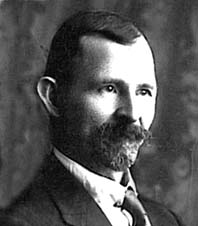 GHL WEDEMEYER b.1825
GHL WEDEMEYER b.1825Photo: Courtesy B & Y Kemp
The "WEDEMEYERs of Eastern Australia" is divided into 10 chapters with appendices. These appendices extend over 5 sections. If you wish to read the chapters in order, select the links at the bottom of each page or use the "Quick Nav" at top right. If you wish to select individual chapters, please click on the top left link to the Sitemap page. Please note the WEDEMEYER photo galleries here.
Contents of this Website are subject to Copyright © by Philip Strong, & allow fair academic use. See here.
Do you have information, opinion or a question relating to either this site’s contents or its copyright? Please use the e-mail link available at the bottom of each page. I look forward to corresponding with you.
Introduction and Acknowledgements.
This chapter describes the origin of the WEDEMEYER family in Moringen and Goslar. It documents my g-g-g grandfather Johann Heinrich WEDEMEIER, born 31 March 1752, and It introduces my g grandfather GHL WEDEMEYER (GHL) (pictured at the top of this page), who was born on 10 Mar 1825 at Goslar, Germany.
We tell of my family's important events in Moringen (baptism, confirmation, marriage and burial)… all which probably occurred at the St Martin's Church (pictured below).
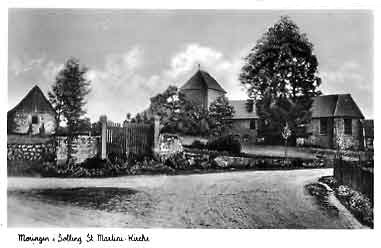 St Martin's Church Moringen. 1954 Postcard.
St Martin's Church Moringen. 1954 Postcard. This stone building was the town church during the period discussed in this chapter, and was originally built in about 1100 AD.
Subsequent chapters of this site tell the story of GHL’s emigration to Australia in 1854, and his life in Gayndah, then Drummers Creek and also Yarrol near Mt Perry, and finally in Walla, all in Queensland, Australia. Significant research is presented about Elizabeth DAVIS and her family. Elizabeth was the wife of GHL, and she was also an Irish "Pauper Immigrant". The following chapters focus on GHL's children (Harry, Louis, Minnie, Elizabeth, John and Maggie), also followed by appendices of significant documents, which also develop Elizabeth’s story.
Thanks to my various cousins who have readily provided information, photos etc. Note the photo above, which is the only photo in existence of GHL and is courtesy of Yvonne and Bob Kemp. Particular thanks to Alice McArthur (née WEDEMEYER) who has collaborated in the research. The story of the WEDEMEYERs would not have been possible without her extensive research and help. Alice died on 2 Sep 2017 at the age of 93… I will miss her. I am most grateful for information from Joan Johnson of Bundaberg, who has been researching microfilms of early Bundaberg newspapers, as well as Pat Smith of Mount Perry who researched information from the early Mount Perry rate books, and Wilfried Hartje from Moringen who has accomplished most significant collation and reconstruction of Moringen records following the fire which destroyed much of the early Moringen archival material. Especial thanks to my professional researchers; Dr Sylvia Möhle from Göttingen, who has transcribed Goslar parish records and has recently obtained Moringen and Fredelsloh records; and also Marianne Eastgate from Brisbane who has accessed Queensland State Archives material. Finally, a recent breakthrough was made in Fredelsloh records due to the kind help of a Fredelsloh historian.
WEDEMEYER family's origins in Goslar and Moringen
- Inside this chapter:
- Moringen Origins |
- Guild Records |
- Reconstruction and collation |
- Further Moringen-Fredelsloh research |
- Troubled Early Times |
- Goslar Origins |
- Goslar City |
- German-born Descendancy |
Moringen Origins
The earliest records of my family were in a 1766 church confirmation register in Moringen. The register recorded my g-g-g grandfather as Johann Heinr. Wedemeier, born 31 March 1752, his age at confirmation was 14 years and 1 month and his results of work at school were bad or “schlecht”!
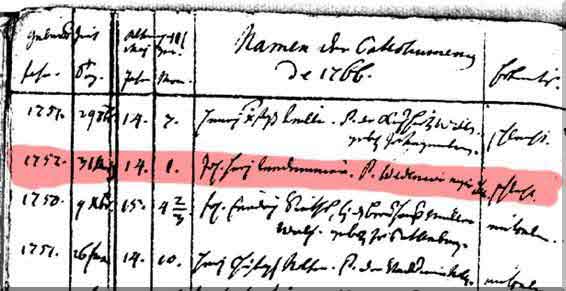 1766 Moringen Confirmation Register … the WEDEMEIER entry is highlighted.
1766 Moringen Confirmation Register … the WEDEMEIER entry is highlighted. Copy: Courtesy Wilfried Hartje
Johann Heinrich WEDEMEIER / WEDEMEYER became a Schuhmachermeister or Master Shoemaker in Moringen. He married Dorothee Rosine STAKE on 29 Oct 1776.
They had the following children:
- Johanne Dorothee Magdalene (abt 1778-) (not yet a definite inclusion)
- Johann Heinrich Ludwig (Ludwig) (1779-)
- Johann Heinrich Zacharias (1782-)
The first-born son Ludwig was my g-g grandfather.
Sources: i) Johann Heinrich WEDEMEIER: Moringen confirmation register. Kirchenbuchamt, Hannover.
ii) Dorothee Rosine WEDEMEYER: Moringen Burials 1832,
page 187, number 37. Kirchenbuchamt, Hannover.
Notes: i) : The Moringen church records — baptisms, marriages
and burials — are only available from 1794, with early records from 1601-1638.
The intervening records were probably lost due to a fire. However, the confirmation
lists are available from 1728 and thus give us information on children born
from approx. 1714 onwards.
ii) : The father of Johanne Dorothee Magdalene was not named in her Confirmation Register entry. Nevertheless she was provisionally included in my family due to the date and the similarity of first names.
Guild Records
The Moringen Guild Lists helped us after by archive records were destroyed. Wilhelm Rose held the position of Moringen archivist for a long period. He prepared a manuscript on the Guilds, which contained an Index of the Guild members, date of their mention in Moringen guild files, a notation when they were Guild master (GM) and location of the member's guild file in the Moringen town archives. WEDEMEYER /WEDEMEIER mentions in the Index are as follows:
List of guild members
- Butchers’ guild: Wedemeyer, Chr. 1833 GM; Wedemeyer G. L. 1768; Wedemeyer, J. G. 1768; Wedemeyer, Otto. 1815; Wedemeyer, 1822.
- Shoemakers’ guild: Wedemeier, Heinrich. 1851; Wedemeier, Johann Christian. 1777 / 1781; ††Wedemeier, Johann Heinrich. 1774 / 1781; Wedemeyer, Friedrich. 1845 / 1865 GM / 1861 GM; Wedemeyer, Heinrich. 1830 GM / 1844 GM / 1866 GM; Wedemeyer, Johann Heinrich Christoph. 1814; ††Wedemeyer Ludwig. 1884; ††Wedemeyer, Zacharias. 1814 / 1826 GM.
- Joiners’ guild: Wedemeyer, G. 1849 GM.
- Negative results: Merchants’ guild, linen weaver guild; tailors’ guild; bakers’ guild; masons’ guild; smiths’ guild; turners’ guild.
Source: Rose, Wilhelm. Beiträge zur Geschichte der Moringer Gilden. Moringen; 1963; 66.
Note: †† Member of my WEDEMEYER family.
The Wilhelm Rose booklet enabled us to find the earliest shoemaker guild file relevant to my WEDEMEYER family. Frau von Hülsede, the Moringen Archivist, kindly confirmed from this file that my g-g-g grandfather Johann Heinrich WEDEMEIER was listed as a new master shoemaker on 12 March 1774.
Reconstruction and collation
Wilfried Hartje and other Moringen historians have been engaged in general reconstruction and collation of records. These were a necessity follow the archives fire Wilfried has most kindly shared his WEDEMEYER information, and the Moringen story of the WEDEMEYERs could not have been told without his help. Dr Sylvia Möhle has also obtained specific WEDEMEYER records from the Hannover Lutheran Archives (Kirchenbuchamt). The Möhle and Hartje WEDEMEYER results have been combined. See the shortened descendancy report at the end of this page, or the full report placed in the Appendix.
Further Moringen-Fredelsloh research results
These arose from the search for an ancestor of General Albert Coady WEDEMEYER… Ernst Georg Friedrich (Friedrich G.) WEDEMEIER, b. 5 Feb 1825 in Fredelsloh, son of Wilhelm WEDEMEIER and Engel Christine HENKELMANN. Friedrich G. might be a relation to "my" WEDEMEYERs! The search for the General's ancestors is described at the beginning of Appendix 1.
These enquiries in Fredelsloh then led to further information: A local Fredelsloh historian has kindly provided information about earliest records of WEDEMEYER in the area. We now have a record of our Friedrich G’s g-g-grandfather Jurgen Andreas WEDEMEYER, b. 1698, who then died in Fredelsloh in 1776. A very promising line of enquiry which may tie together my Moringen WEDEMEYERs and the General’s Fredelsloh WEDEMEYERs! Full details are here, including a descendancy report from Jurgen to our Friedrich G. WEDEMEYER.
Now read on for my g-g grandfather's life after he left Moringen.
Ludwig WEDEMEYER— Troubled Early Times
Life was not as Ludwig expected in his early life. He finished his apprenticeship and graduated to a "Schuhmachergeselle" or "Shoemaker journeyman". In the tradition of those days, he would have left the place where he served his apprenticeship and travelled for 3 years and a day (Gesellenjahre) from town to town, working under various master craftsmen as a day labourer.
Ludwig met Johanne about 1805 in Goslar. She was Johanne Christiane Henriette GIESECKE, the youngest daughter of the weapon smith, Georg Christoph GIESECKE. It was probable that the weapon smith was a tough character. Thus news that Georg’s youngest daughter Henriette was pregnant to Ludwig would have made a troubled situation. Eventually they married on 30 Sep 1805 in the Lutheran Marktkirche, and daughter Johanne Dorothea Henriette was born the following month on 29 Oct 1805. Ludwig was aged almost 26 at that time and was also still a Shoemaker journeyman.
Ludwig remained in Goslar and did not become a Master Shoemaker in Moringen. He would have normally have taken over his father's business as a first-born son. However, Ludwig was not a qualified shoemaker when his father died. He would have needed to complete his apprenticeship under another master shoemaker.
The end result was that Ludwig’s younger brother Johann Heinrich Zacharias became Master Shoemaker in 1814 and Guild master of the Shoemaker Guild in 1826 in Moringen. Nonetheless, Ludwig was recorded as Master Shoemaker in Goslar in 1825 when my g-grandfather was born. At that stage there must not have been ill-feeling between the brothers, since Johann Heinrich Zacharias was godfather at my g-grandfather’s baptism.
Source: Church records of the various Goslar parishes. Held in the Protestant Lutheran Combined Church Office, Goslar.
Notes: (1): The microfilmed church records from Goslar have not been placed with similar records in the Hannover Kirchenbuchamt. However, they are available in part from the National Church Archives in Wolfenbüttel.
(2): Johanne Christiane Henriette GIESECKE was baptized in Saint Jacob the Elder Church of Goslar, but was married in 1805 in the Markt Parish of Goslar. She could not marry in her original church as a Protestant, since St Jacob changed to Roman Catholic in 1804. The Protestant members of St Jacob then attended the Protestant churches in the Parishes of Frankenberg, St. Stephani and Markt.
(3): The Protestant burial registers in Goslar were searched for WEDEMEYERs: Frankenburg to 1843, St Stephani to 1834, Markt to 1867. My g-g grandparents Ludwig and Johanne Christiane Henriette were not found, neither were any other WEDEMEYERs who were related to me.
Goslar Origins
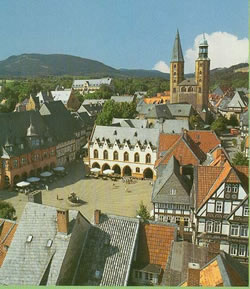 Market Place of the Markt Parish
Market Place of the Markt ParishGoslar, near Hanover, Germany.
Georg Heinrich Friedrich Louis WEDEMEYER (GHL) was born on 10 Mar 1825, in the former Market Parish, Goslar, near Hannover, Germany. The twin steeples of the Marktkirche (Market Church of St. Cosmas & St. Damian) in the photo to the left were important to my family…. my gg-grandparents were married in this Evangelischekirche (Protestant church) and my g-grandfather GHL was baptised there. He became a shoemaker. However, as the youngest child, he didn’t have much chance of inheriting the family business.
The image of the church shows the Marktplatz (Market Place) of the Markt Parish: The building on the far side of the square is the Council Chambers, and behind that are the twin steeples of the Market Church. Far left background is the Imperial Palace.
Goslar City
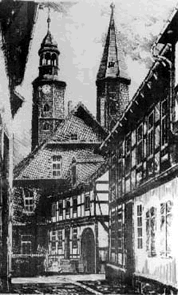 Drawing of Marktkirche
Drawing of MarktkircheCourtesy of D. Franke
This mediaeval city was founded in 922 by Heinrich the 1st and accumulated its wealth mainly by mining silver ore. The source of silver was the Rammelsberg or "Mountain of Fate" which only closed down in 1988. The mine was the only one in the world, which had operated for more than a 1,000 years.The Emperors moved their seat of power to Goslar, building the Imperial palace, which strengthened Goslar's position as the "secret capital" of the German empire. The image to the right is a pen and ink drawing showing a view of the twin steeples of the Market Church or Marktkirche, from the Bergstrasse. The church was built in 1540.
As a result, Goslar was considered one of the most important political centres and also rose to become a centre of Christian belief, with 47 churches, chapels and monasteries. Heinrich III built the palace between 1039 and 1056. The palace was important for the next 200 years and was the Imperial palace for Friedrich I Barbarossa (Red Beard) (1123-1190). Friedrich I was Holy Roman Emperor, King of Germany, leader of a Crusade. The buildings gradually fell into disrepair until Wilhelm I, King of Prussia, comprehensively restored them 1868 – 1879. At the end of the Franco-Prussian War, the German Empire was founded and on Jan 18, 1871 King Wilhelm I became Kaiser Wilhelm I. The old emperor's palace now became a symbol of German re-unification and the new Emperor's power.
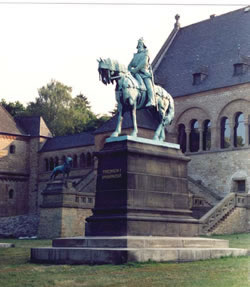 Imperial Palace (Der Kaiserpfalz)
Imperial Palace (Der Kaiserpfalz) Photo: Courtesy DJ Paton 1990.
The statues on their horses at the front of the palace said it all... Wilhelm I was represented as Wilhelm der Grosse (the Great) with a Prussian helmet (Pickelhaube) on the left, and the Holy Roman Emperor Friedrich I Barbarossa on the right. The Imperial Palace was attached to the Royal Chapel of St Ulrich, which contains the preserved heart of Heinrich III.
The image on left shows the Imperial Palace with Friedrich I Barbarossa on his horse in the foreground. The Royal Chapel is on the left of this photo.
During WWII Goslar escaped bombing due to the nearby army hospital. The mine and the old town were placed on the UNESCO World Heritage List in 1992. Goslar is on the northern boundary of the Harz National Park. The isolated wilderness of the Harz Mountains is mentioned in legends about werewolves. In summary, Goslar's intact mediaeval city and its outlying areas make an outstanding tourist destination, perhaps you should visit the Marktplatz and stay at the Hotel Kaiser Worth (see photo below).
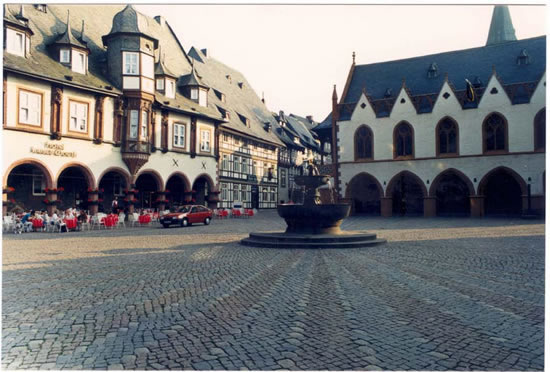 Close up of the Market Place: the Rathaus and the Hotel Kaiser Worth
Close up of the Market Place: the Rathaus and the Hotel Kaiser Worth Photo: Courtesy DJ Paton 1990
The photograph above shows the Market Place with the Rathaus (Council Chambers) on the right, a steeple of the Market Church at the right background, and the Hotel Kaiser Worth on the left (once the Guild Hall of the tailors and merchants). For more information, visit the official Goslar Website.
Descendancy Report
The following is a highly abridged report of data of German born WEDEMEYERs in my family. The complete report has been placed in the Appendix.
- (1) Johann Christoph STAAKE
- b. abt 1730
- & Catharina Elisabeth HILMER
- b. 18 Jan 1733, Moringen.
- m. 27 Jul 1752
- | (2) Dorothee Rosine STAKE
- | b. 12 Oct 1752, Moringen.
- | d. 29 Apr 1832, Moringen.
- | & Johann Heinrich WEDEMEYER
- | b. 31 Mar 1752
- | d. 26 Nov 1800, Moringen.
- | m. 29 Oct 1776
- | | (3) Johanne Dorothee Magdalene WEDEMEYER (not yet a definite inclusion)
- | | b. abt 1778
- | | (3) Johann Heinrich (Christian) Ludwig (Ludwig) WEDEMEYER
- | | b. 21 Dec 1779, Moringen.
- | | & Johanne Christiane Henriette GIESECKE
- | | dau of Georg Christoph GIESECKE (weapon smith) & Johanne Friederica RITTER
- | | b. 28 Aug 1785, Goslar, Hanover, Germany.
- | | bap. 4 Sep 1785, Saint Jacob the Elder Church, Goslar, Germany.
- | | m. 30 Sep 1805, Markt Parish of Goslar, Hannover, Germany.
- | | | (4) (Georg) Heinrich Friedrich Louis (Louis) WEDEMEYER
- | | | b. 10 Mar 1825, Markt Parish, Goslar, Hanover, Germany.
- | | | d. 5 Oct 1885, Walla, Queensland Australia
- | | | & Elizabeth DAVIS
- | | | b. 1834, Parish of Killare, Mullingar PLU, Co. Westmeath, Ireland
- | | | m. 27 Sep 1862, “House of Mr Wedemeyer”, Gayndah, Queensland, Australia.
- | | (3) Johann Heinrich Zacharias WEDEMEYER*
- | | b. 27 Feb 1782
- | | occ. 1814: Master Shoemaker. 1826: Guild master of the Schumachergilde.
- | | & Hanne Christiane Dorothee LÖHNIG
- | | b. 19 Aug 1780, Moringen.
- | | m. 28 Jun 1809, Moringen.
- | | (3) Johann Heinrich Zacharias WEDEMEYER*
- | | b. 27 Feb 1782
- | | & Dorothee Elisabeth KÜSTER
- | | b. 1 Dec 1797, Moringen.
- | | m. 19 Feb 1828, Moringen.
The Story Continues
- Chapter 2: Emigration from Germany.